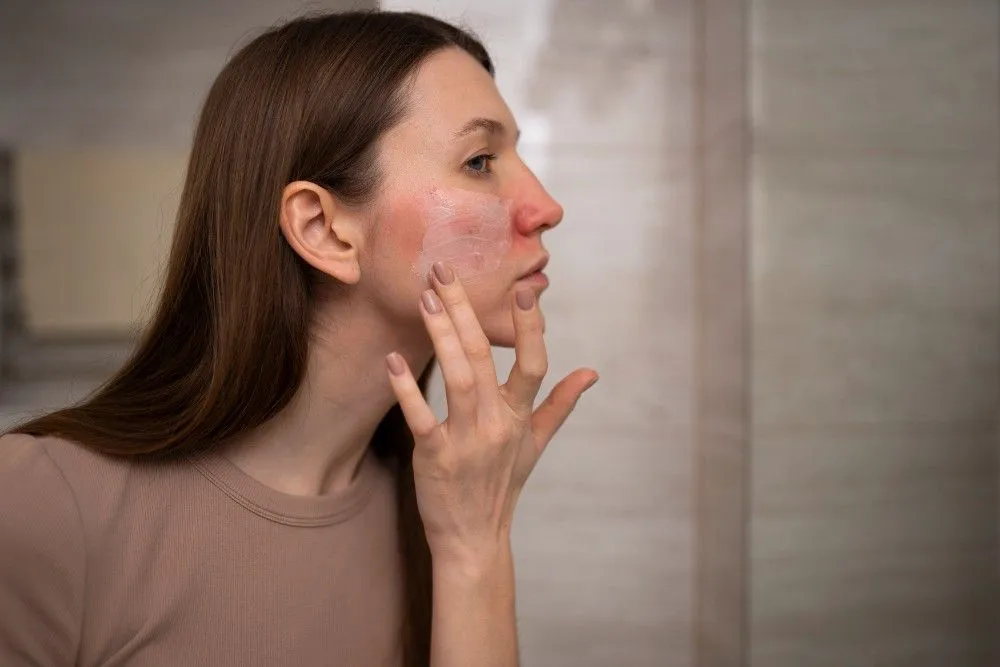|
A black line on a nail may indicate a splinter hemorrhage, tiny blood vessel damage under the nail bed, often caused by trauma, infections, or underlying health conditions like diabetes or endocarditis. While usually harmless, persistent or unexplained lines could signal serious issues like melanoma. Nail hygiene, diet, and protective care help prevent recurrence. |
Ever spotted a thin, dark streak on your fingernail and immediately jumped to the worst conclusion? You’re not alone. That black line on the nail can look pretty alarming at first glance. Sometimes it fades away like it never happened. Other times, it lingers and makes you question whether it’s harmless or something deeper.
Let’s face it: nails are tiny health messengers. That black streak on the nail might just be a cosmetic concern, or a signal worth paying attention to. This blog walks through what that line really means, and what should (and shouldn’t) freak you out.
What Is a Black Line on the Nail?
So, let’s start simple. That black line under the nail, often described as a vertical stripe, can show up on one nail or multiple. It can be thin or thick, faded or dark, short or running the entire nail length.
The most common name for this is linear melanonychia, especially when the line is brown to black in color. But here’s where it gets tricky: it isn’t always just pigmentation. Sometimes, it’s blood. Yep, blood trapped beneath the nail. That’s where things shift from “probably nothing” to “okay, maybe let’s look closer.”
Now, not all dark nail lines are red flags. People with darker skin tones often get natural pigmentation in their nails. That’s common, expected, and nothing to worry about. But if the streak is new, especially in light-skinned individuals, and if it changes in shape or color, it might not just be pigment. That’s when you start hearing terms like nail splinter hemorrhage or nail bed hemorrhage thrown around.
What Are Splinter Hemorrhages?
Let’s make it clear. A splinter hemorrhage doesn’t mean you’ve got a splinter. It just looks like one. These appear as tiny, narrow lines under the nails, usually vertical and dark in color, from red to brown to black.
They’re caused by small blood vessels under the nail getting damaged and leaking blood. That blood gets trapped and forms what looks like a thin black line on the fingernail.
Here’s how to spot them:
-
They usually run in the direction of nail growth.
-
They don’t change color with pressure.
-
They stick around as the nail grows, then move toward the tip before vanishing.
In most cases, nail trauma black line is the top suspect. Stubbed toes, slammed fingers, biting your nails, any of those can lead to this kind of line. And they’re nothing to lose sleep over. But when there’s no injury and the line shows up anyway? That’s when the plot thickens.
Can a Black Line on the Nail Be a Splinter Hemorrhage?
Yes, it absolutely can. That vertical black line on the fingernail may look like ink or dirt, but it’s probably blood. Specifically, it’s a splinter hemorrhage nail. Here’s what usually happens:
The capillaries beneath the nail break open (either from injury or another cause), and blood leaks out, getting trapped between the nail and the nail bed. Since nails are translucent, that thin black mark becomes visible.
But why does it matter? Well, if you didn’t hit or injure your nail, a hemorrhage like that might be a hint toward something going on internally. It can be a clue pointing toward underlying health issues, some minor, some not.
Signs That Suggest a Splinter Hemorrhage
Let’s break this down. What separates a harmless black line on a nail from one that needs attention? Look at what comes with it. If it's just a dark streak from nail trauma, it'll grow out. But if it’s hanging around, or you're spotting red or brown lines under nails, keep these points in mind:
Visual signs:
-
Color: Starts red or brown, turns black.
-
Size: About 1–3 mm wide.
-
Shape: Runs lengthwise, not sideways.
-
Mobility: Grows out with the nail, not fixed in place.
Other signs:
-
No pain or tenderness? It might be old trauma.
-
Pain or swelling around the nail? It could be an infection.
-
Line appears suddenly without trauma? Time to call a doc.
If the line multiplies, spreads, or shows up on multiple nails at once, that’s another clue. Rarely, this might suggest conditions like endocarditis or even melanoma, though those cases are outliers. Still, better to be cautious than late.
Common Causes of Splinter Hemorrhages
Honestly, the causes of a black line on a nail are pretty varied. Sometimes it’s simple. Other times it’s complex. Around 20% of these cases link to obvious nail trauma. The rest? Well, that’s where it gets interesting.
1. Trauma or Nail Injury
-
Banging your nail against something
-
Aggressive manicures or nail-biting
-
Tight shoes are causing toe pressure
2. Fungal Nail Infections
-
Long-term shoe wear (especially in sports)
-
Athlete’s foot spreading to nails
-
Damp environment
3. Bacterial Endocarditis
-
Bacterial infection in the heart lining
-
Bacteria travel through the bloodstream
-
Clots and inflammation affect tiny vessels in the nails
4. Vasculitis
-
Inflammation of blood vessels
-
Can restrict blood flow
-
Leads to bleeding under nails
5. Diabetes
-
High sugar damages small vessels
-
Slower healing can trigger hemorrhages
6. High Cholesterol
-
Fat buildup narrows vessels
-
Blood flow interruptions cause mini hemorrhages
7. Subungual Melanoma
-
Rare skin cancer under the nail
-
More common in thumbs or big toes
-
Risk is higher with changing, widening lines
Quick Comparison
|
Cause |
Associated Symptoms |
Risk Level |
|
Trauma |
Tenderness, swelling, recent injury |
Low |
|
Fungal Infection |
Yellowing, thickened nail, odor |
Medium |
|
Endocarditis |
Fever, fatigue, nail spots |
High |
|
Vasculitis |
Rash, joint pain, fatigue |
High |
|
Diabetes |
Slow healing, numb feet |
Medium-High |
|
High Cholesterol |
Chest pain, fatigue, poor circulation |
Medium |
|
Melanoma |
Pigment changes, spreading black line |
Critical |
When to Worry About a Black Line on Your Nail
Not all streaks are warnings. But some are. Here’s when to pay close attention:
-
The line suddenly appears with no injury.
-
It gets darker or wider over time.
-
You see multiple nails affected.
-
The nail shape starts changing.
-
There’s pain or swelling.
Also, keep an eye on nail changes that don’t go away. A streak on a nail that sticks around for more than six weeks? That deserves a second look. Especially if it grows darker, bleeds, or comes with systemic symptoms like fatigue or fever.
How Are Splinter Hemorrhages Diagnosed?
Your doctor will start with a visual inspection. But depending on other symptoms, the following tests may be performed:
-
Blood Culture – Checks for bacteria in blood (especially for endocarditis)
-
Erythrocyte Sedimentation Rate (ESR) – Indicates inflammation
-
Echocardiogram – Looks for heart valve infections
-
Biopsy – Needed if melanoma is suspected
Doctors will also ask questions about recent injuries, medication, travel, or family history. The diagnosis always begins with ruling out trauma. If no trauma is found, the focus shifts to internal causes.
Treatment Options and Management
If it’s just trauma, the best thing you can do? Leave it alone. Let it grow out. No poking, no digging.
But if infection or another health condition is involved, treatment depends on that root cause. Some need topical antifungals, others require full systemic treatment. Here’s a quick look:
For nail trauma:
-
Keep it clean
-
Let it grow out
-
Trim nails carefully
For fungal infections:
-
Antifungal creams or oral meds
-
Avoid wet socks and tight shoes
For medical causes:
-
Heart conditions = antibiotics
-
Diabetes = glucose control
-
High cholesterol = diet change + statins
Again, the black line won’t go until the cause is handled. So treating the splinter hemorrhages helps the nail recover, too.
How to Prevent Black Lines and Splinter Hemorrhages
Most of this is common sense, but worth repeating.
-
Trim nails straight, not rounded.
-
Don’t bite or pick at cuticles.
-
Wear shoes that actually fit.
-
Use gloves when handling chemicals or doing manual work.
-
Keep nails clean and dry.
-
Eat a nutrient-rich diet, especially vitamins B12 and D.
-
Schedule regular checkups if managing heart conditions or diabetes.
Avoiding nail trauma black line is the first line of defense. After that, keep your body healthy. The nails usually follow suit.
Conclusion
Seeing a black line on a nail might send you down a Google rabbit hole. But most of the time, it’s not life-threatening. If it comes after an injury, just wait it out. It’ll disappear as the nail grows. But if the nail splinter hemorrhage appears without any reason, or keeps coming back, don’t ignore it. There might be a bigger picture.
Always better to be sure than sorry. Nail health, as small as it seems, can tell you stories your body’s been trying to whisper for weeks.
Frequently Asked Questions
Why do I suddenly see a thin black line on my fingernail?
Sudden appearance of a thin black line might be a splinter hemorrhage from unnoticed trauma or an internal issue. Watch for other symptoms and consult a physician if unsure.
How long does a splinter hemorrhage take to disappear?
Typically, splinter hemorrhages fade as the nail grows out, usually within a few weeks to a couple of months, depending on nail growth rate.
Can I treat a splinter hemorrhage at home?
If it’s caused by trauma and not painful or spreading, yes. Keep nails clean and trimmed, and avoid further injury. See a doctor if it worsens.
Are black lines on nails contagious?
No, they’re not contagious. However, if caused by a fungal infection, it may spread through shared items like nail tools or socks.
Does vitamin deficiency cause nail discoloration?
Yes. Deficiencies in B12 and D can lead to nail changes, including black or dark lines, discoloration, and brittle nail texture. A balanced diet helps.
Reviewed by







